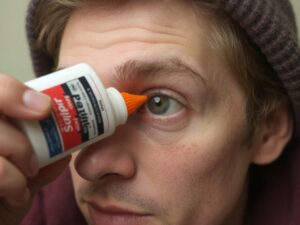A few columns back I mentioned the RE:CM 10 year old wine awards, and how some of the wines I tasted during the judging (I was filming not judging) were not very good. I couldn’t mention the best ones, as the results had not yet been made public. I can now talk freely as the awards have been handed out.
The top scoring wine of the competition was the Boekenhoutskloof Syrah 2003. What a wine.
As I was filming the judging process – a similar endeavor as filming paint dry, just with more slurps – I would duck behind the screen where the open bottles were standing, away from the judges’ eyes, and steal quick tastes of the wines.
There were a few wines that stopped me cold. The Boekenhoutskloof was one of these wines. It showed beyond any doubt, that South African reds can age well. Not taste old and okay, but mature gracefully with the building of tertiary flavours to complement the primary fruit flavours and secondary flavours from fermentation and oak ageing.
What! That sounded rather like la-di-da pretentious wine speak. okay. Let’s try again. Simplistically we can break down flavours (aromas, really) in wine into three broad groups. Primary, Secondary and tertiary. Primary aromas are those from the fruit. Secondary aromas are created by things such as fermentation, and ageing in oak. Right, with me so far?
As wine ages a whole bunch of chemistry is taking place in the bottle. For example, may I quote briefly form the Oxford Companion to Wine:
A fine wine ready for bottling . . . may contain tannins, anthocyans, tannin-anthocyan complexes, and more complex colloids such as tannin-polysaccharides, tannin-salts, and polymerized anthocyans. Polymerization continues in bottle.
Phew. Science.
Chemistry was never my strong point, so I am not going to try and explain things that I have the barest mental grip on.
While all this polymerization is going on resulting in softer and lighter older red wines, those flavor compounds which make up the primary and secondary aromas in the wine are also doing a chemical waltz, resulting in tertiary aromas. Some people call this a bouquet.
A bouquet – apart from being the campest word in the dictionary – is a wine term that no one really agrees on. The most useful definition is for that array of aromas found in older wines. These aromas can only occur once all the chemical toing and froing in bottle happen.
Let’s go back to that Boekenhoutskloof Syrah. I’ve tasted plenty older South African red wines (10 years plus) that while alive and kicking, haven’t really aged and produced this ‘bouquet’. The Boekenhoutskloof, however, was full of primary red and black fruit aromas, spices, as well as floral notes with great perfume. In amongst all of this there were faint hints of leather, and spicy tobacco that are arriving from this time spent slowly ageing in Boekenhoutskloof’s cellar.
That description, while mildly accurate sucked. The wine seduced, invigorated, it stood up and shouted, “I’m not old yet you young whippersnapper, take me out to the fucking ball game.” and proceeded to shoot wildly from a six-shooter, while kissing the heroine. Not sure that one worked either.
How to describe well aged red wines? Imagine someone you find attractive sitting on an oversized, big pillowed, luxurious couch. Imagine them on the edge of the couch, nervous, all elbows and knees. Now imagine them leaning back into the couch, letting the pillows take their full weight as they sink into the couch, muscles relaxing until they are still. The former is a red wine in youth. Not unattractive, just ungainly, awkward and out of sorts. An aged wine is your attractive friend relaxed on the couch. The same thing, just far better to look at, soothing, and, if you play your cards right, possibly very satisfying.
It becomes hard to describe wines that have aged well and have added this so-called bouquet. This difficulty is a sign of complexity. Aromas shift and change, like whispers in an echo chamber.
Chrisitan Eedes, former editor of the now sadly deceased Wine Magazine and one of my preferred lunch partners has reignited this 10 year old wine competition in the hope that more and more South African producers see the benefits of holding back some of their wines to sell, or show, in years to come when they are closer to reaching full maturity.
While there were many wines with overt problems in the tasting – age can be cruel to wine too – it is immensely gratifying for South African wine lovers to see how our wines can age. While I enjoyed the other two wines that were in the tope three – the Remhoogte Estate Wine 2003 and the Rudera Syrah 2003 – the Boekenhoutskloof stood at least a head taller, a wine that is without any patriotic flag-waving, world-class.





